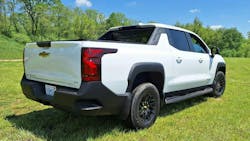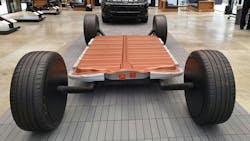Chevrolet’s Silverado wasn’t the first in the parade of electric vehicles that manufacturers released to the buying public in recent years, perhaps because the General Motors division’s engineers and designers started with a clean slate rather than adapt an existing 1500-series pickup to electric propulsion. Chevy showed a prototype Silverado EV at a trade show in March 2022, when two competitors had already begun building theirs, and had it in production a year later.
The initial EV pickup model was in Work Truck (WT) trim, aimed squarely at commercial users such as construction firms. But for more than a year, Chevrolet soft-pedaled the actual introduction into fleets and offered only limited drives of the WT-EV.
More drives came during a late-spring 2024 show-and-tell event in Detroit, and even then, time behind the wheel of a few plain-looking, stark-white EV pickups was short. But we reporters didn’t feel slighted because hosts showed off an upscale version, called RST, and offered several hours of wheel time in copies of the new consumer-oriented model.
Chevy Silverado RST enhancements
Aside from a considerably fancier interior, the RST adds a bed reminiscent of the old Avalanche pickup, with a drop-down rear cab wall, called a Midgate, lengthening floor space into the backseat area. Rear-wheel steer is another RST feature, and it noticeably reduces a turning circle. An adjustable air-ride suspension cushions any road shock and can raise or lower the truck body to suit pavement or rough terrain.
Read also: What's inside the Ford Lightning electric pickup truck?
A small fleet of gloss-black RST pickups were our wheels for much of a day, and we experienced the power, ride, handling, comfort, and quietness of these top-of-the-line Chevy EV pickups. Much of the mileage was racked up on suburban routes with a variety of streets and roads.
While on expressways we engaged GM’s Super Cruise feature, usable only on multilane highways, that allows drivers to take their hands off the wheel. This ably operates a truck but requires a driver to pay attention to what’s happening. If inward-facing cameras see the driver is distracted, the system flashes a warning and shuts off if the driver doesn’t respond.
Super Cruise monitors pavement stripes and uses mapping knowledge added by programmers to keep a vehicle in its lane. More than 750,000 miles of roadway in North America have been mapped— “enabled,” engineers call it—and more are being added every day. Super Cruise observes traffic ahead and to each side, then adjusts speed and changes lanes to pass when necessary. It will bring the truck to a complete stop and start out again, as in stop-and-go traffic.
How does a Chevy Silverado ride?
Overall, the Silverado EV was smooth, quiet, and had e-power a-plenty, especially when I wanted to move briskly. It’s based on GM’s Ultium platform, which really is a platform when displayed without a truck body. A rectangular box, hung between the front and rear suspension assemblies, houses two tiers of electric cells to form the battery in a Silverado EV.
The 3,000-pound battery pack boosts a Silverado EV’s curb weight to about 8,700 pounds, which is almost 3,500 pounds more than a gasoline-engine 1500 series crewcab. But that low-slung weight also stabilizes the EV truck and helps it corner flat and ride smoothly. It is a comfortable truck and, with the RST trim, a pleasing one to drive or just sit in. There is abundant storage in the center console and elsewhere in the vehicle, and large info screens keep a driver well informed.
Depending on which of three WT types the fleet buyer chooses, a Silverado EV in WT form will go an EPA-certified 393 to 450 miles between charges. Quick-charging adds 100 miles in 10 minutes, and charging to 80% takes about 40 minutes. In output, the EV-WT’s ratings are 510 horsepower and 615 lb.-ft. of torque. Tow rating is 10,000 to 12,500 pounds. Payload capacity is 1,500 pounds.
Wowed by Silverado RST WOW
WOW, for “wide-open Watts,” is an exciting RST feature not available on WTs. It temporarily boosts output to 754 horsepower and 785 lb.-ft. for crazy-quick acceleration. We demonstrated this for ourselves on a test track in Ypsilanti, west of Detroit. WOW is engaged by switching into the performance mode, confirmed by a Batman-like winged icon in the digital info display.
One by one, we lined up in our six EV pickups and, when prompted, hit our go-pedals and went. During my turn, I grasped the steering wheel, stomped on the accelerator and felt g-forces in my eyeballs as the truck rocketed forward. There was little tire squeal because a traction-control function limits torque but lets the two motors put down as much as possible to all four wheels.
My driving partner took his turn and was likewise wowed by WOW. I don’t know our terminal speeds, but they were probably around 70 mph in 0.1 mile or so. (Car and Driver clocked a Silverado RST-EV’s 0 to 60 mph time at 4.1 seconds, compared to 3.3 seconds for a GMC Hummer, which uses the same battery, and 2.6 seconds for a Tesla Cybertruck.)
Most of our driving, though, involved observing our RST-EV truck’s road manners and powertrain characteristics as we crawled at 25 mph or so through affluent suburbs along Lake St. Clair (police there enforce the speed limit, our hosts warned us beforehand) and cruised more briskly over winding roads farther inland.
Like other EVs, the Silverado has several levels of regenerative braking, which turns the motors into generators to send electricity into the battery and extends range. The strongest level allows “one-pedal” driving: Ease off the accelerator, and the truck slows at a moderate rate without using the service brakes. At one point I let it slow us to a crawl, then moved away. Brake lights activate when doing this to warn following drivers that the electric Chevy is slowing down. I preferred a less aggressive setting for most situations.
Most instruments, including the speedometer, are projected through the 11-inch screen directly ahead of the driver, while road speed and the posted limit are repeated in a heads-up display in the windshield.
As one would expect, the electricity in the underfloor battery can be used to power accessories and hand tools via 120-volt AC outlets placed inside the cab and in the pickup bed. It will also power an entire house if the grid goes down. GM has set up a division to sell the control boxes and mount them on a customer’s property. Chevy dealers will arrange to install a charger to juice up the truck.
Chevrolet also has a new Equinox-EV compact SUV, which we drove almost as much as the Silverado EVs, and a larger Blazer-EV SUV, available in a police pursuit configuration that we rode in (and held on for dear life) as retired Michigan State Police officers chased each other around a parking lot; a civilian version is also available.
Meanwhile, Chevy is intensifying its push into commercial truck sales with an extensive Envolve program. The Silverado EV-WT trim, with prices from $72,905 to $79,800, is leading that charge into what one exec called an “emissions-free future.”
Below is a walk-around look at the Chevy Silverado EV from Fleet Maintenance, a sibling publication to Construction Equipment.
About the Author

Tom Berg
Tom Berg is widely acknowleged as one of the top truck writers in the industry. He has covered construction for more than 34 years, and has test-driven well over 150 trucks for Construction Equipment.

